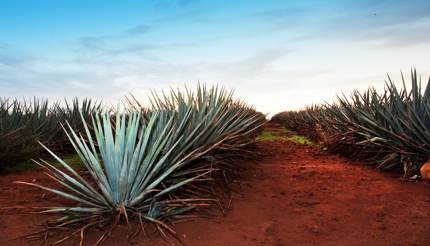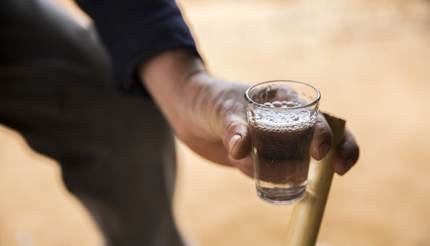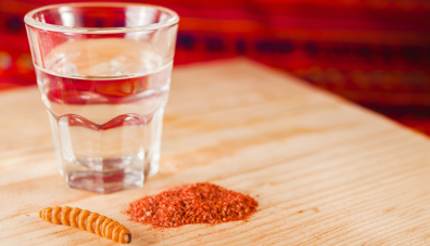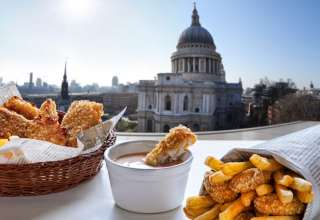The mythical and magical spirit of mezcal continues to make its mark on the international spirits industry – and for good reason
Tequila, a distilled alcoholic drink created from the blue agave plant has made a name for itself around the world – and anyone who has tasted this distinctive beverage neat or as a shot with salt and lemon can vouch for its rather distinctive flavour. Following swiftly behind this notable Mexican tipple is mezcal, and although both these spirits are produced from the agave plant, that is where the similarities end.

Mezcal has been around for a while but has often been overshadowed by tequila, until recently. This year, in particular, sees a strong focus on this deliciously smoky and earthy spirit as it begins to emerge on bar shelves across the globe. Tequila is actually a type of mezcal, in the same way that bourbon and scotch are types of whiskeys. However, tequila and mezcal are made from different kinds of agave: mezcal can be made from more than 30 varieties, while tequila can only be made from blue agave.
What exactly is mezcal?
In a nutshell, mezcal is the hipster version of the distilled beverage, meaning it is the ‘craft’ side as it is often produced with centuries-old methods and in small quantity.
The first noteworthy thing is the agave plants, some of which can take up to 35 years to fully mature and weigh up to 200 pounds (91kg) depending on the species. The heart of the agave plant, the piña (meaning pineapple because of its appearance), contains the rich latent sugars that are needed to create the spirit.
The word “mezcal” comes from the term mexcalli, which translates to “oven-cooked agave”; and indeed the production process of mezcal involves roasting the agave plant. As a result, mezcal tends to be powerfully earthy and complex with an essence of sweetness.
Where does mezcal come from?
Throughout Mexico, agave fields abound, particularly in the state of Oaxaca – where most of mezcal is made. To be called mezcal, the spirit must be produced in one of the certified mezcal growing areas, such as Oaxaca, Michoacan, Zacatecas, San Luis Potosí, Tamaulipas, Guerrero and Guanajuato.
It is estimated that Mexico has about 9,000 mezcal producers who create about six million litres of mezcal annually.
The history of mezcal
Whether mezcal was created before or after the Spanish Conquest of Mexico is highly debatable. One thing we do know is agave was once regarded as a sacred plant in the country and indigenous people would cook and ferment the heart of the agave in rituals. Mezcal also has a myth surrounding it – some locals would tell you that a lightning bolt was believed to have struck an agave plant, which in turn fermented the juice. Regardless of which stories you like, this seemingly magical spirit has garnered the name “elixir of the gods”.
Then during the conquest, the Spanish, who had been implementing distillation processes since the 18th century, ran out of hard liquor and went in search of other substitutes. Some said it was this desire that led them to create mezcal as we know today. The spirit was originally produced in small-scale rural distilleries with raw materials gathered from the nearby areas. Differing from the production of tequila, which went industrial in the 1900s, the process of making this more exclusive spirit has remained more rustic and hands-on even today.
How is mezcal produced?
The traditional production of mezcal takes place in small-scale production facilities, where it is handcrafted. These production houses throughout Mexico are called fábricas or palenques. Each house implements different techniques, often passed down through generations.

The process to create mezcal includes four main steps.
Stage 1
The first stage includes the harvesting of the plants and the extraction of the piña by slicing off the leaves and roots of the agave. The piñas are then roasted in covered pit ovens for up to three days. As a result of the underground roasting, mezcal obtains its smoky flavour. This roasting or cooking process is not used in the production of tequila.
Stage 2
After the piñas have been sufficiency roasted, they are crushed and mashed (traditionally by a stone wheel turned by a horse), and left to ferment in large barrels, mixed with water – this is where the rich sugars are released.
Stage 3
The resulting liquid goes through a distillation process, in either a clay or copper pot, and is modified further to create the final version of the spirit, which can reach an alcohol level of up to 55%.
Stage 4
It is possible for some of the liquid to be left to age in barrels from one month to four years.
Similar to tequila, mezcal is distilled twice to raise the alcohol percentage, and the final product is very much dependent on the species of agave that is used, the distillation process that is employed, and the fruits or herbs that are added.
The mezcal worm
You won’t necessarily discover a “worm” – the larva of a moth that can infest agave plants – in every bottle of mezcal. However, it can be added during the bottling process for several reasons. Two of these reasons include adding it as a marketing tactic, or enhancing a particular flavour.

How should you drink mezcal?
The most traditional way to drink mezcal is to consume it neat, allowing you to taste the unique and bold flavours of the spirit. Mezcal is also used in cocktails, posing as the perfect substitute for tequila in a Paloma, vodka in an Espresso Martini or whiskey in an Old Fashioned. However, considering the time and effort that goes into making mezcal, it should be sipped rather than thrown back in a single shot.
It is also popular to accompany the drink with sliced lemon, orange or lime, and sprinkle it with a mixture of chilli peppers and ground fried larvae. In comparison to other spirits, mezcal deserves to be treated more like a single malt – a tipple that you should nurse and take the time to appreciate.
This article was first published in 2016 and has been updated on 15/08/19
Before you go, take a look at our Mexico Travel Guide.
If you found this interesting, you might also enjoy:






